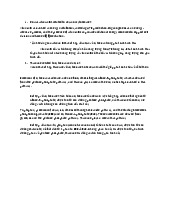













Preview text:
Summarize Biodiversity Book
Chapter 1. What is biodiversity ?
1.1 Marion Island
o This section uses Marion Island as a case study to illustrate the
concept of biodiversity in a real-world setting.
o Marion Island, located in the Southern Ocean, is home to a rich
variety of species, including elephant seals, fur seals, seabirds, and
numerous plant species. It demonstrates the complexity of
biodiversity, as the island supports over 500 species across various
taxa, from invertebrates to vascular plants.
1.2 What is Biodiversity?
o Biodiversity is defined as the variety of life, encompassing all levels
of biological organization. This section explains that biodiversity
includes genes, species, ecosystems, and the interactions among them.
o The Convention on Biological Diversity offers a formal definition,
which emphasizes the variability among living organisms from all
sources (terrestrial, marine, and aquatic ecosystems).
o The authors explain that biodiversity covers all organisms that have
ever existed, not just those currently alive, extending the concept to
include past life forms preserved in the fossil record.
1.3 Elements of Biodiversity
The chapter identifies three main elements of biodiversity:
• Genetic Diversity: The variation in genetic material within species,
populations, and individuals. This encompasses differences in
nucleotides, genes, chromosomes, and genomes, and is critical for
species' adaptation and survival.
• Organismal Diversity: The variety among species and taxonomic
groups, from individuals to species, genera, and families. This
includes differences in morphology, behavior, and ecological roles.
• Ecological Diversity: The diversity of ecosystems, habitats, and the
ecological processes that occur within them. This involves the
interactions between species, including their roles in energy flow,
nutrient cycling, and community dynamics.
1.4 Measuring Biodiversity
o This section tackles the challenges of quantifying biodiversity.
o There is no single measure that can capture the full scope of
biodiversity, due to the complexity and diversity of life forms.
o Species richness (the number of species in an area) is the most
commonly used metric, but this only accounts for one dimension of biodiversity.
o This chapter explains that biodiversity can also be measured by
looking at genetic differences, ecosystem diversity, and the functional
roles species play in ecosystems. The authors emphasize that different
methods of measuring biodiversity can lead to varying outcomes, and
each method has its strengths and limitations. 1.5 Summary
o The chapter concludes by summarizing the importance of
understanding biodiversity across different scales and levels.
o It reiterates that biodiversity is more than just the number of species—
it includes genetic diversity, ecological diversity, and the complex
interactions that maintain ecosystems.
o It also highlights the need for effective measures to quantify and
protect biodiversity, given its essential role in maintaining ecological
balance and supporting human life.
Chapter 2: Biodiversity Through Time
2.1. Introduction
1. Temporal Dynamics of Biodiversity: The chapter explores how
biodiversity changes over time.
2. Sources of Information: It discusses the sources that contribute to
understanding biodiversity's evolution.
3. History of Life: Provides a brief overview of the history of life and key patterns in biodiversity.
4. Major Processes: Examines processes like diversification and
extinction that shape biodiversity patterns.
5. Current Species Numbers: Considers the number of extant species as a result of these dynamics.
6. Broader Historical Context: Focuses on the larger historical context,
with human-induced changes addressed in Chapter 5.
2.2 Sources of Information
• 2.2.1: Flossil record
o Fossil Record and Biodiversity: Much of the modern geological
landscape originates from past biodiversity, reflected in the fossil
record, which offers insights into the history of life on Earth.
o Limitations of the Fossil Record: Understanding this history is
constrained by three main factors:
▪ The fossil record is incomplete, with only a small percentage
of species ever leaving fossils.
▪ A tiny fraction of the fossil record has been recovered.
▪ The record is biased toward more abundant, widespread, and
longer-lived species, often neglecting soft-bodied organisms.
o Example of Dinosaurs: Despite being well-studied, the dinosaur
fossil record is limited; only 285 out of an estimated 900–1200
genera are known from fossils, with many based on single specimens.
o Incompleteness of Primate Fossils: Similarly, only about 7% of
all primate species are known from fossils, highlighting the fossil record's limitations.
o Value of the Fossil Record: Despite its incompleteness, the fossil
record provides a valuable history of life on Earth, allowing for the
analysis of biodiversity changes over geological time.
o Higher Taxa as Surrogates: Due to the constraints of the fossil
record, the chapter will often focus on changes in higher taxa
rather than individual species, which serve as effective surrogates for measuring biodiversity.
• 2.2.2: Molecular envidence
o Increasing Importance: Molecular evidence is becoming more
significant in understanding biodiversity alongside the fossil record.
o Phylogenetic Trees: Molecular comparisons allow for the creation
of branching trees that illustrate evolutionary relationships, with
greater sequence differences indicating earlier divergence.
o Molecular Clock: The "molecular clock" concept helps estimate
the timing of evolutionary events based on the rate of molecular divergence.
o Discrepancies: Fossil and molecular evidence can conflict
regarding the dates of first appearances, with molecular data often
suggesting earlier origins for some groups.
o Underestimation by Fossils: The fossil record may underestimate
the dates of first appearances due to the low likelihood of fossilization.
o Complementary Insights: Despite their discrepancies, fossil and
molecular evidence together provide valuable insights into the history of life on Earth.
2.3 A Brief History of Biodiversity
This section outlines significant events that have influenced biodiversity:
• Mass Extinctions: Earth has experienced five major mass extinction
events, resulting in the loss of a large number of species.
• Evolutionary Radiations: Following mass extinctions, periods of rapid
speciation occur, leading to increased biodiversity.
2.4 How Many Extant Species Are There?
• Estimating the number of current species is challenging, with
estimates ranging from 5 million to over 30 million. Many species,
especially invertebrates and microorganisms, remain undiscovered,
highlighting the need for further research. 2.5. Summary
1. Increase in Biodiversity: Biodiversity has generally increased since
the first organisms appeared, despite over 90% of species becoming extinct.
2. Patterns of Growth: This increase is not continuous; it includes
periods of radiation and stabilization, punctuated by mass extinctions.
3. Mass Extinctions' Impact: Mass extinctions, though a small portion
of total extinctions, significantly disrupt biodiversity development.
4. Concentration of Biodiversity: Most biodiversity comes from a few
taxonomic groups, while many groups are not very diverse.
5. Species Estimates: Approximately 13.5 million species are estimated
to exist, with only 1.75 million described, though these figures may contain large errors.
Chapter 3. Mapping biodiversity
3.1. Introduction
1. Uneven Distribution of Biodiversity: Biodiversity is not evenly
distributed across the Earth or its environments; species richness
varies in complex spatial patterns.
2. Focus of Research: Research has primarily targeted well-known taxa,
like plants, birds, mammals, mollusks, and fish, with little information
available for highly diverse groups such as bacteria, fungi, and insects.
3. Objectives of the Chapter: The chapter aims to:
o Discuss the effects of spatial scale on biodiversity levels.
o Identify areas with extremely high and low biodiversity.
o Examine spatial gradients in biodiversity and their underlying mechanisms.
o Explore spatial congruence among different groups and the
potential for broader generalizations about biodiversity distribution.
4. Species Richness and Diversity: The chapter distinguishes between
local and regional species richness and defines alpha, beta, and gamma diversities:
o Alpha Diversity: Number of species in local communities.
o Beta Diversity: Species turnover between communities.
o Gamma Diversity: Total number of species in a region.
3.2 Issues of Scale
Biodiversity must be assessed at different scales, from local ecosystems to
global patterns. The scale of observation impacts how biodiversity is interpreted and measured.
3.3 Extremes of High and Low Diversity
Certain ecosystems, such as tropical rainforests and coral reefs, are known
for their exceptionally high biodiversity, while areas like deserts and polar
regions have much lower biodiversity due to harsher environmental conditions.
3.4 Gradients in Biodiversity
o Biodiversity often follows specific gradients, particularly latitudinal
gradients, with species richness generally increasing from the poles toward the equator.
o Factors like climate, habitat complexity, and geological history contribute to these patterns. 3.5 Congruence
o Congruence refers to the correlation between the biodiversity of
different groups of organisms within the same geographic area.
o Understanding congruence can help prioritize areas for conservation efforts. 3.6 Summary
o Mapping biodiversity is essential for understanding ecological
dynamics and informing conservation strategies.
o Continued research and data collection are crucial for effectively addressing biodiversity loss.
Chap 4: Does biodiversity matter?
4.1. Introduction
1. Complexity and Change: Biodiversity is complex, has changed
dramatically over time, and is unevenly distributed.
2. Fundamental Question: The chapter addresses the crucial
question of whether biodiversity matters.
3. Value of Biodiversity: Biodiversity's values are divided into:
o Use Values: Includes direct-use and indirect-use values, as
well as relationships to ecosystem function.
o Non-Use Values: Encompasses option, bequest, existence, and intrinsic values.
4. Value Presentation: The order of value presentation does not
imply relative importance, and some biodiversity exploitation
examples discussed may be unsustainable or unethical.
4.2 Direct-Use Value
Biodiversity provides numerous direct benefits, such as food, medicine, and
materials. The chapter emphasizes how diverse ecosystems contribute to
agriculture and fisheries, which are vital for human survival.
4.3 Indirect-Use Value
Biodiversity underpins essential ecosystem services, including:
• Nutrient Cycling: Maintaining soil health and fertility.
• Water Purification: Natural processes that filter and cleanse water sources.
• Climate Regulation: Biodiversity plays a role in stabilizing the
climate through carbon sequestration.
4.4 Non-Use Value
Beyond practical benefits, biodiversity has intrinsic value and cultural
significance. Many societies value biodiversity for its beauty and the
connections it fosters with nature. 4.5 Summary:
1. Direct Use Values: Involves the consumption or production of
marketable commodities (e.g., food, medicine, ecotourism), though
many exploitation patterns are unsustainable.
2. Indirect Use Values: Harder to quantify but vital for human well-
being, encompassing essential services provided by biodiversity.
3. Artificial Systems Limitation: Current technology cannot replicate
the life-supporting functions of natural systems.
4. Ecosystem Functioning: Increases with small numbers of species,
indicating ecological equivalency, but effects diminish with greater species richness.
5. Species Richness Benefits: Higher species richness enhances
redundancy and resilience, improving ecosystem reliability.
6. Non-Use Values: Include option value (for future use), bequest value
(for future generations), existence value (independent of use), and
intrinsic value (inherent worth).
Chapter 5. Human Impacts
5.1. Introduction:
1. Human Impact on Biodiversity: Humans have significantly
negatively impacted biodiversity, despite its essential benefits.
2. Recent Decline: While biodiversity has generally increased over
geological time, the late Quaternary has seen a marked decline due to
human activities, leading to reduced biological heterogeneity.
3. Focus of the Chapter: The chapter addresses:
o Species Loss Levels: Analyzing the extent of species losses. o Proximate
Causes: Examining the four main causes:
overexploitation, habitat loss and degradation, introduced
species, and extinction cascades.
o Ultimate Causes: Considering fundamental factors like human
population size, growth, and the scale of human activities.
5.2 Species Extinctions
Human activities have accelerated species extinction rates, driven by habitat
destruction, pollution, and overexploitation. The chapter discusses specific
examples of endangered species and the consequences of their potential loss.
5.3 Populations, Individuals, and Genetic Diversity
The decline of populations reduces genetic diversity, compromising species'
resilience to environmental changes and increasing their vulnerability to diseases.
5.4 Threats to Biodiversity
Key threats to biodiversity include:
• Habitat Loss: Driven by urbanization, agriculture, and deforestation.
• Invasive Species: Non-native species can disrupt local ecosystems.
• Climate Change: Altered weather patterns and rising temperatures affect species adaptation.
5.5 The Scale of the Human Enterprise
The chapter highlights the cumulative impacts of human activities on
biodiversity, emphasizing the need for conservation actions to mitigate these effects. 5.6 : Summary:
1. Long-Term Biodiversity Loss: Biodiversity loss, particularly species
extinctions, has been linked to human activities since prehistoric colonization.
2. Recorded Extinctions: Over 1,000 plant and animal species have
been recorded as extinct since 1600.
3. High Impending Extinction Rates: Current extinction rates are
estimated to be significantly higher than background rates in the fossil record.
4. Principal Causes: The main proximate causes of biodiversity loss are
direct exploitation, habitat loss and degradation, effects of introduced
species, and extinction cascades.
5. Ultimate Causes: The ultimate causes relate to human population
size, growth rate, and the scale of human activities.
Chapter 6: Maintaining biodiversity
Chapter 6: Maintaining Biodiversity 6.1 Introduction
1. Origin of ‘Biodiversity’: The term emerged in the context of concerns
over natural environment loss, emphasizing its importance.
2. Convention on Biological Diversity: The book relies on this
convention, viewing it as a significant international step toward long-
term biodiversity maintenance, despite its flaws and the absence of some countries like the USA.
3. Historic Commitment: The Convention was the first binding global
treaty addressing biodiversity comprehensively, including genetic
diversity and recognizing biodiversity conservation as a shared human concern.
4. Broader Context: The maintenance of biodiversity encompasses
various human activities beyond species extinction and protected areas,
illustrating its wide-reaching implications.
5. Framework for Discussion: The chapter will explore the Convention’s
42 Articles, providing a framework to discuss biodiversity maintenance
and encouraging readers to understand the underlying ideas despite the complex legal language.
6.2 Objectives of the Convention
The Convention on Biological Diversity (CBD) outlines several key objectives:
• Conservation of Biological Diversity: The primary goal is to protect species and their habitats.
• Sustainable Use of Biodiversity: Ensuring that natural resources are
used in a way that does not harm their availability for future generations.
• Fair and Equitable Sharing of Benefits: Aiming for the equitable
distribution of benefits derived from genetic resources, including
through technology transfer and financial support.
6.3 General Measures for Conservation and Sustainable Use
The chapter discusses various measures that can be implemented to conserve
biodiversity effectively, including:
• Protected Areas: Establishing and managing protected areas to
safeguard critical ecosystems and species.
• Sustainable Resource Management: Developing practices that allow
for the sustainable use of biological resources, such as fisheries and
forestry, while ensuring ecosystem health.
6.4 Identification and Monitoring
This section emphasizes the importance of identifying and monitoring
biodiversity to inform conservation actions:
• Species Identification: Accurately identifying species is crucial for assessing conservation needs.
• Monitoring Changes: Regularly monitoring changes in species
populations and habitats helps evaluate the effectiveness of
conservation strategies and informs necessary adjustments.
6.5 In-situ Conservation
In-situ conservation refers to the protection of species in their natural
habitats. This section covers:
• Strategies for In-situ Conservation: Implementing conservation
actions within natural ecosystems, such as habitat restoration and management.
• Role of Protected Areas: Highlighting the significance of national
parks and reserves in preserving biodiversity in situ.
6.6 Ex-situ Conservation
Ex-situ conservation involves conserving species outside their natural habitats. Key points include:
• Methods of Ex-situ Conservation: Techniques such as breeding
programs in zoos, botanical gardens, and seed banks are essential for preserving genetic diversity.
• Importance for Species Recovery: Ex-situ conservation can be
critical for species that are critically endangered and may not survive in
the wild without intervention.
6.7 Sustainable Use of Components of Biological Diversity
This section discusses strategies for ensuring the sustainable use of biodiversity:
• Ecotourism: Promoting responsible tourism that benefits conservation
efforts while providing economic support to local communities.
• Sustainable Harvesting Practices: Implementing guidelines for the
sustainable collection of resources, ensuring that use does not deplete
populations or damage ecosystems.
6.8 Incentive Measures
Incentive measures can encourage conservation efforts among various stakeholders:
• Economic Incentives: Financial mechanisms, such as payments for
ecosystem services, can motivate landowners and communities to
engage in biodiversity-friendly practices.
• Policy Incentives: Establishing policies that support conservation
initiatives and sustainable practices is vital for achieving biodiversity goals.
6.9 Responses to the Convention
The chapter outlines the responses of various countries and organizations to the CBD:
• National Strategies: Many nations have developed national
biodiversity strategies and action plans (NBSAPs) to align with the objectives of the CBD.
• International Collaboration: Cooperation between countries and
international organizations is essential for addressing transboundary
biodiversity issues and sharing best practices. 6.10 : Summary
1. Origin of ‘Biodiversity’: The term emerged in the context of concerns
over natural environment loss, emphasizing its importance.
2. Convention on Biological Diversity: The book relies on this
convention, viewing it as a significant international step toward long-
term biodiversity maintenance, despite its flaws and the absence of some countries like the USA.
3. Historic Commitment: The Convention was the first binding global
treaty addressing biodiversity comprehensively, including genetic
diversity and recognizing biodiversity conservation as a shared human concern.
4. Broader Context: The maintenance of biodiversity encompasses
various human activities beyond species extinction and protected areas,
illustrating its wide-reaching implications.
5. Framework for Discussion: The chapter will explore the Convention’s
42 Articles, providing a framework to discuss biodiversity maintenance
and encouraging readers to understand the underlying ideas despite the complex legal language.


